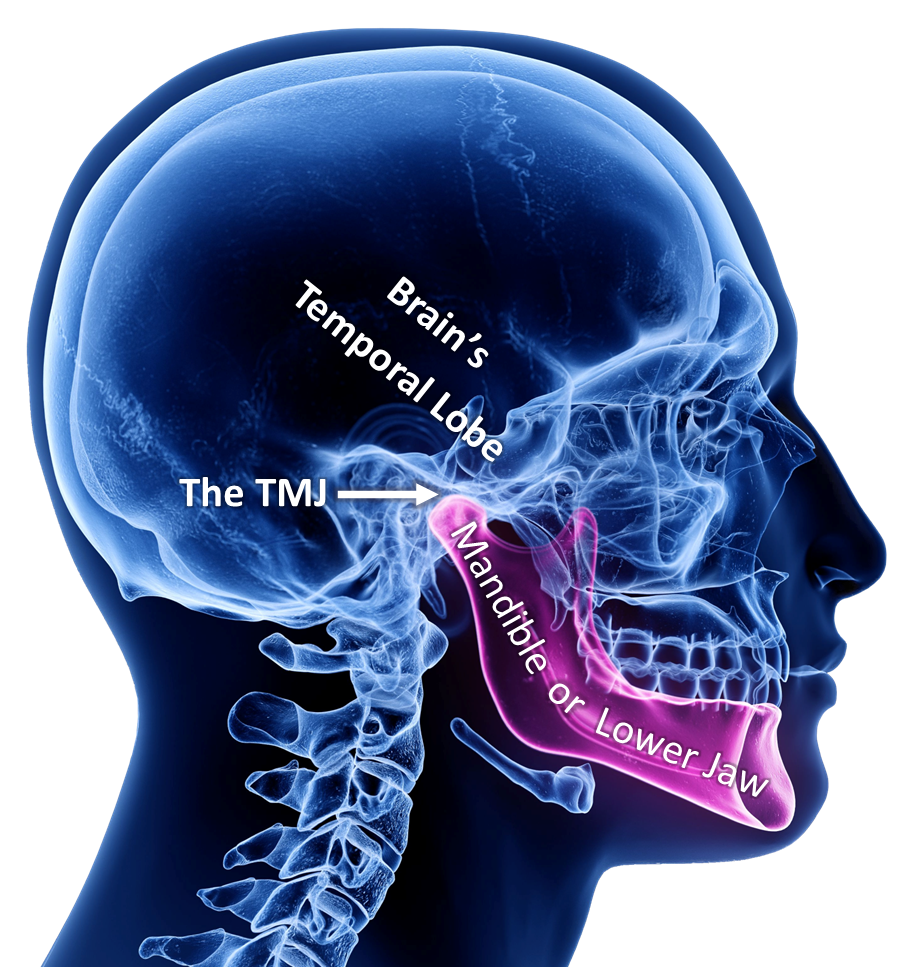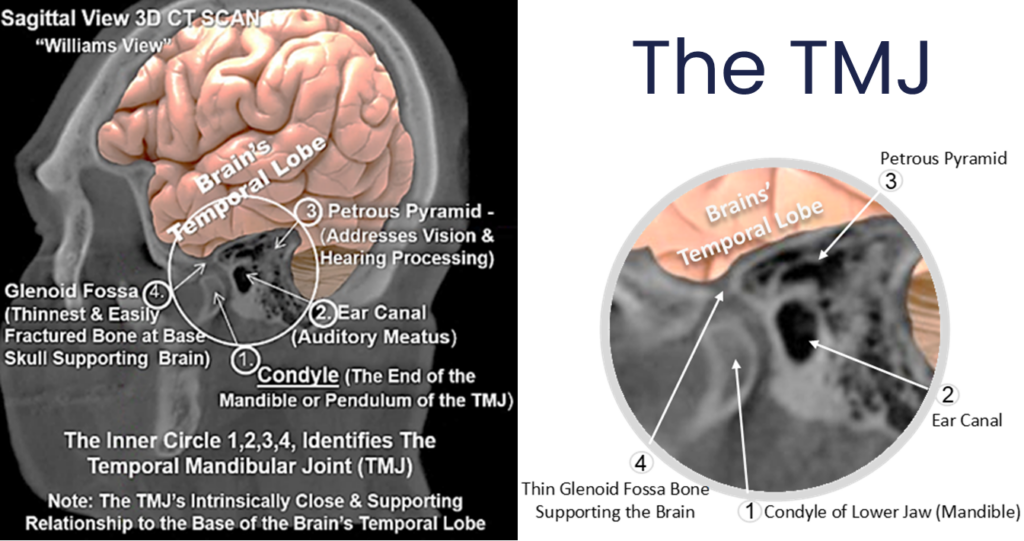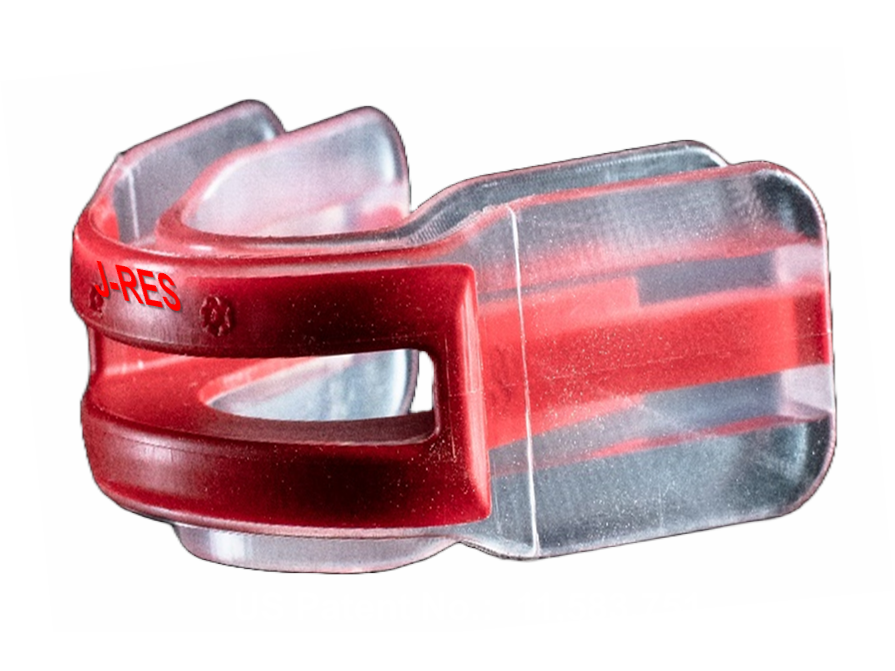
Diagnosing, Treating, and Preventing Concussions/Traumatic Brain Injuries and the Tormenting Symptoms
Breakthrough Innovation in the Science of Concussions and TBIs
Dr. Edward D. Williams of the Jaw Joint Science Institute has pioneered breakthroughs over the course of +20 years of researching the crisis of concussions and traumatic brain injuries (TBIs). He has developed a new healing protocol that addresses the symptoms of TBIs as well as the invention of a mouthguard-like device that prevents the fractures found to be associated with TBIs. Through his work, he has been granted several patents and military research awards at the forefront of this medical breakthrough!

Introducing the Missing Link to Solving the Concussion/TBI Crisis

Society, at large, has not considered the critical connection between the temporomandibular joint (often referred to as temporal mandibular joint or TMJ) and the symptoms of concussions and TBIs. With the temporal lobe of the brain resting just above the lower jaw it becomes clear why the temporal lobe of the brain has become the center focus of the cognitive symptoms of concussions
Impact testing headforms have lacked the inclusion of this delicate anatomy, resulting in a rampant diagnosis of TBIs despite industry best efforts to protect the skull from impact forces using helmets. It is in fact, the lower jaw that traumatizes the brain through the TMJ!
New Standard of Diagnosis for Concussions, TBIs, and TMDs


Through the use of 3DCT scanning technology we have discovered fractures involving the temporal bones which support the temporal lobe of the brain, linking TBIs and the TMJ. These fractures are varied, involving the delicate structures of the TMJ and have been directly linked to the symptoms of TBIs, concussions and temporal mandibular disorders (TMDs).
Healing Concussions and TBIs
Our revolutionary diagnosis begins with 3DCT imaging and a clinical evaluation. Our innovative approach provides a clearly defined treatment plan to diminish or eliminate the symptoms of concussions, TBIs, and TMDs.
Our successful treatment protocol is non-invasive, non-opioid-based, and can restore the patients quality of life in as little as 4 months.
These Are the Treatable Symptoms of TMJ Fractures Associated with Concussions, TBIs, and TMDs
- Irritability
- Depression
- Mood Swings
- Hearing Loss
- Poor Sleep Habits
- Mental Confusion
- Behavioral Changes
- Living in Mental Haze
- Personality Variations
- Loss in Concentration
- Facial and Joint Pains
- Intellectual Difficulties
- Sinus-Like Headaches
- Nausea and/or Vomiting
- Impaired Sense of Balance
- Impaired Visual and Auditory Processing
- Grinding, Clicking or Popping Sounds When Opening or Closing the Mouth
- Migraine-Like Headaches
- Pulsating Pains Behind the Eyes
- Attention/Perception Problems
- Reduced Problem-solving Ability
- Post Traumatic Stress Disorders
- Severe Headaches and Dizziness
- Increase Sensitivity to Light and Noise
- Memory Loss, More Forgetful Than Ever
- More Hostile and Intense Than Usual
- Raspy Voice and Tongue-tied Speaking
- Rotator Cuff and Frequent Stiff Neck
- Unrealized Physical Loss of Strength
- Higher Propensity for Strokes (CVA)
- Decreased Ability to Cope With Stress
- Tinnitus and Internal Carotid Artery Disease
- An Increase in Unusual Behavior
- Perhaps a Causation for Suicides
Recurring Headaches are the Most Prominent Symptom
These Are the Treatable Symptoms of TMJ Fractures Associated with Concussions and TBIs
- Irritability
- Depression
- Mood Swings
- Hearing Loss
- Poor Sleep Habits
- Mental Confusion
- Behavioral Changes
- Living in Mental Haze
- Personality Variations
- Loss in Concentration
- Facial and Joint Pains
- Intellectual Difficulties
- Sinus-Like Headaches
- Nausea and/or Vomiting
- Impaired Sense of Balance
- Impaired Visual and Auditory Processing
- Grinding, Clicking or Popping Sounds When Opening or Closing the Mouth
- Migraine-Like Headaches
- Pulsating Pains Behind the Eyes
- Attention/Perception Problems
- Reduced Problem-solving Ability
- Post Traumatic Stress Disorders
- Severe Headaches and Dizziness
- Increase Sensitivity to Light and Noise
- Memory Loss, More Forgetful Than Ever
- More Hostile and Intense Than Usual
- Raspy Voice and Tongue-tied Speaking
- Rotator Cuff and Frequent Stiff Neck
- Unrealized Physical Loss of Strength
- Higher Propensity for Strokes (CVA)
- Decreased Ability to Cope With Stress
- Tinnitus and Internal Carotid Artery Disease
- An Increase in Unusual Behavior
- Perhaps a Causation for Suicides
Recurring Headaches are the Most Prominent Symptom
Prevention and Performance Enhancement: J-RES (Jaw-Restorer)


The J-RES device is more than a mouthguard, its the evolution of headgear protection, a true game-changer. By repositioning the jaw away from the delicate anatomy of the TMJ, J-RES prevents TMDs, concussions and TBIs. By allowing the user to clench their teeth while breathing through the mouth, it has also been proven to enhance overall human performance (that’s strength AND endurance). This human performance enhancement has been shown to accelerate physical therapy recovery as well! But its applications do not stop there, its repositioning also lends itself to prevent sleep apnea as J-RES prevents upper airway obstructed breathing.
All while allowing the user to drink, spit, and talk through the open airway, this is the next generation of the outdated mouthguard!
Benefits of J-RES
- Prevents TMJ Fractures and the onset of Concussions, TMDs, and TBIs
- Enhances Strength-Training, Physical Endurance, and Physical Therapy Recovery
- Eliminates Chinstrap Constraint of Helmets, Promotes Headgear Stability, and Comfort
- Mitigates the Cheek-Riser’s Recoil Force Against the TMJ
- Enables TMJ and Skull Protection During Training and Field Operations
- Anterior Airway Space Increases Breathing Capability and Articulate Speech
- Mitigates Migraines under Exertion, Increasing Self-Reliance and Resilience
- Prevents Upper Airway Obstruction, Diminishing Sleep Apnea
- Enhances and Saves the Career Expectancy of Military Personnel
- Absorbs G-Force & Jerk-of-Acceleration Impacts Against TMJ, Improving G-Force Capability and Aviation Performance
- Mitigates Impact Forces of Helmet Constraint, Canopy Opening, Weight Distribution, and PLF in Parachuting Operations
- Protects Upper & Lower Teeth Against Facial Impacts and Clinching Episodes
Benefits of J-RES
- Prevents TMJ Fractures and the onset of Concussions, TMDs, and TBIs
- Enhances Strength-Training, Physical Endurance, and Physical Therapy Recovery
- Eliminates Chinstrap Constraint of Helmets, Promotes Headgear Stability, and Comfort
- Mitigates the Cheek-Riser’s Recoil Force Against the TMJ
- Enables TMJ and Skull Protection During Training and Field Operations
- Anterior Airway Space Increases Breathing Capability and Articulate Speech
- Mitigates Migraines under Exertion, Increasing Self-Reliance and Resilience
- Prevents Upper Airway Obstruction, Diminishing Sleep Apnea
- Enhances and Saves the Career Expectancy of Military Personnel
- Absorbs G-Force & Jerk-of-Acceleration Impacts Against TMJ, Improving G-Force Capability and Aviation Performance
- Mitigates Impact Forces of Helmet Constraint, Canopy Opening, Weight Distribution, and PLF in Parachuting Operations
- Protects Upper & Lower Teeth Against Facial Impacts and Clinching Episodes
Take the Next Step Towards Healing Today and Changing Sports Tomorrow
Don’t let debilitating symptoms control your life any longer. There’s a path to recovery, and it begins here, at the Jaw Joint Science Institute.
